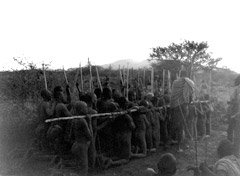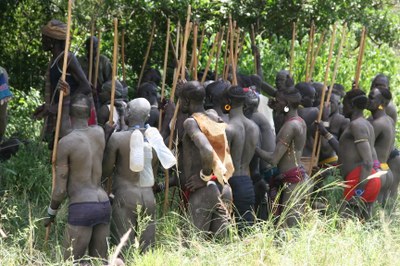Age and age sets
 At dawn, Garana names the new Geleba age set at Kurum, January 1991. (David Turton).
At dawn, Garana names the new Geleba age set at Kurum, January 1991. (David Turton).
 Members of the terru age-grade kneel before the Bara who discipline them verbally and with whips in a 'kneeling' (korda kôma) ceremony, Dirikôrro, 2010.
Members of the terru age-grade kneel before the Bara who discipline them verbally and with whips in a 'kneeling' (korda kôma) ceremony, Dirikôrro, 2010.
As amongst other East African herders, men are formed into named ‘age sets’, and pass through a number of ‘age grades’ during the course of their lives. Married women have the same age grade status as their husbands. By becoming a member of an age set (teny) a man achieves full social adulthood (hirimo), although this may happen long after he has reached physical maturity. Members of the most recent set to be formed occupy the grade of rora, which may be translated as ‘junior elders’. When a new set is formed, the previous rora become bara, or ‘senior elders’ and the previous bara become karui, or ‘retired elders’.
It is the bara of a local community who are expected to play the leading role in reaching decisions about matters of public concern and to be most active in public meetings. But some bara are more politically ambitious than others, and these will be more active in public life. Some are also more highly regarded than others for their statesmanlike qualities and oratorical skills, although none have the right to make decisions on behalf of the community as a whole.
The rora are often described as the equivalent of the Ethiopian police force or army. Their job is to assist the bara in ensuring the safety of people and of the herds and the smooth running of internal community relations. Depending on the interval between the formation of successive sets, however, this ideal division of tasks may not reflect the social reality for many men. The most recent set, known as Geleba (the Mursi name for the Dassanetch, who live in the lower basin of the Omo), was formed in 1991. This was thirty years after the formation of the previous set, Benna (Stones), which now occupies the bara grade. Because the Geleba set has an age span of thirty years (its youngest members are now around 30 and its oldest members around 60), some senior members of the set, although officially rora, play a role in public decision making which is indistinguishable from that which, according to the ideal, is expected of bara.
Each local group (bhuran) holds its own age set formation ceremony (nitha) in the same year, and according to a strict order of precedence. This begins with the southern group, Ariholi, followed by Gongulobibi and then Dola. Ariholi, which is known as the ‘stomach’ (kiango) of the country, has priority because it was the first part of current Mursi territory to be settled. In 1991 the Ariholi ceremony was held at Kurum, on the left bank of the Omo, and was organised and presided over by the late Ulijeholi Garana.
More information
David Turton, ‘Territorial organisation and age among the Mursi’, in PTW Baxter and U. Almagor (eds), Age, Generation and Time: Some Features of East African Age Organisations, C. Hurst & Company, London, pp. 95-130, 1978.
Related item
A clip from the film ‘Nitha’, showing the culmination of the Ariholi age-set ceremony held at Kurum in southern Mursiland in January 1991. In the very early morning, the new set is given its name (‘Geleba’) by the presiding senior elder, Ulijeholi Garana. This was the first age set to be formed since 1961.

